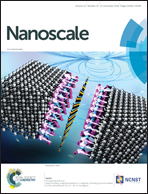3D self-supported Ni(PO3)2–MoO3 nanorods anchored on nickel foam for highly efficient overall water splitting†
Abstract
Electrolyzing water as a sustainable energy source is a promising and appealing method to resolve the environmental crisis. Developing efficient and stable bifunctional electrocatalysts for the hydrogen evolution reaction (HER) and the oxygen evolution reaction (OER) is crucial and challenging in the overall water splitting process. Herein, we report the synthesis of Ni(PO3)2–MoO3 nanorods anchored on nickel foam (Ni(PO3)2–MoO3/NF) within a two-step strategy and their application as a bifunctional water splitting electrocatalyst. The results show that the optimal Ni(PO3)2–MoO3/NF electrodes exhibit superior catalytic activity with robust durability and ultralow overpotentials of 86 mV for HER and 234 mV for OER to achieve 10 mA cm−2 (η10) in alkaline solution. The favorable performance of the obtained catalyst is attributed mainly to the synergetic effect between Ni(PO3)2 and MoO3, as well as the self-supporting porous conductive substrate. As a result, the integrated Ni(PO3)2–MoO3/NF electrodes deliver η10 at a small potential of 1.47 V for overall water splitting, highlighting a promising application as a bifunctional electrocatalyst.



 Please wait while we load your content...
Please wait while we load your content...